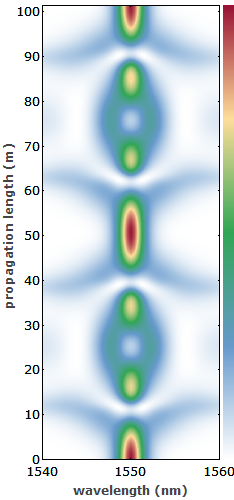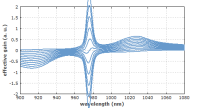Multipass Amplifiers
Definition: an amplifier with multiple passes through the gain medium
More general term: optical amplifiers
German: Multipass-Verstärker
How to cite the article; suggest additional literature
Author: Dr. Rüdiger Paschotta
The gain medium of an optical amplifier can achieve only a limited amount of gain. A method for obtaining a much higher gain is to geometrically arrange multiple passes of light through an amplifier, which is then called a multipass amplifier. The simplest case is that of a double-pass amplifier, where a beam passes the crystal just two times, usually with exactly or nearly opposite propagation directions.
Many multipass amplifiers are based on a laser crystal, which may be end pumped or side pumped, and contain a number of laser mirrors which fold the signal beam path such that it does multiple passes through the crystal. As the beams corresponding to the different passes need to remain well separated, they usually have slightly different angular directions, although they can in principle also be parallel if they have a certain spatial offset. The different beams may strongly overlap in the crystal if the crystal is relatively thin – in the extreme case, part of a thin-disk laser head.

If the case of strong overlap of different passes through the crystal, the overall gain in decibels can be estimated as the number of passes times the single-pass gain. On the other hand, the effective saturation energy is reduced – in case of small overall gain, it is reduced by the number of passes.
For arranging a large number of passes, one is often forced to use beam directions which do not all lie in one plane. The design and alignment of such an amplifier system can be a relatively sophisticated matter.
Apart from being amplified, the signal beam may also experience other effects, such as thermal lensing or nonlinear effects in the crystal. Particularly thermal lensing can strongly affect the transverse beam profile; gain guiding may do that in addition. Such effects (and also the natural beam divergence) may be counteracted by focusing optical elements (usually curved laser mirrors) in the setup. Note that thermal lensing can also deflect beams, if they do not exactly travel through the center of the thermal lens. Optimum alignment may then depend on the applied pump power and also possibly on the signal power.
A regenerative amplifier may be considered as a special kind of multipass amplifier. Here, the multiple passes are arranged not via the geometrical beam path, but with an optical switch. This works well for ultrashort pulses, the duration of which is far below the round-trip time. It is then possible to inject a pulse, let it circulate many times, and then eject it. This principle is convenient for obtaining a very high overall gain in many passes – more than may be feasible in geometrically arranged multiple passes.
Questions and Comments from Users
Here you can submit questions and comments. As far as they get accepted by the author, they will appear above this paragraph together with the author’s answer. The author will decide on acceptance based on certain criteria. Essentially, the issue must be of sufficiently broad interest.
Please do not enter personal data here; we would otherwise delete it soon. (See also our privacy declaration.) If you wish to receive personal feedback or consultancy from the author, please contact him e.g. via e-mail.
By submitting the information, you give your consent to the potential publication of your inputs on our website according to our rules. (If you later retract your consent, we will delete those inputs.) As your inputs are first reviewed by the author, they may be published with some delay.
Bibliography
| [1] | R. Paschotta, case study on a multipass amplifier |
| [2] | W. H. Lowdermilk and J. E. Murray, “The multipass amplifier: theory and numerical analysis”, J. Appl. Phys. 51 (5), 2436 (1980), doi:10.1063/1.328014 |
| [3] | J. Krasinski et al., “Multipass amplifiers using optical circulators”, IEEE J. Quantum Electron. 28 (5), 950 (1990), doi:10.1109/3.55537 |
| [4] | M. Lenzner et al., “Sub-20-fs, kilohertz-repetition-rate Ti:sapphire amplifier”, Opt. Lett. 20 (12), 1397 (1995), doi:10.1364/OL.20.001397 |
| [5] | S. Backus et al., “Ti:sapphire amplifier producing millijoule-level, 21-fs pulses at 1 kHz”, Opt. Lett. 20 (19), 2000 (1995), doi:10.1364/OL.20.002000 |
| [6] | S. Backus et al., “High power ultrafast lasers”, Rev. Sci. Instrum. 69 (3), 1207 (1998), doi:10.1063/1.1148795 |
| [7] | S. Forget et al., “A new 3D multipass amplifier based on Nd:YAG or Nd:YVO4 crystals”, Appl. Phys. B 75 (4-5), 481 (2002), doi:10.1007/s00340-002-0997-2 |
See also: optical amplifiers, regenerative amplifiers, amplifier chains
and other articles in the category optical amplifiers
 |








If you like this page, please share the link with your friends and colleagues, e.g. via social media:
These sharing buttons are implemented in a privacy-friendly way!